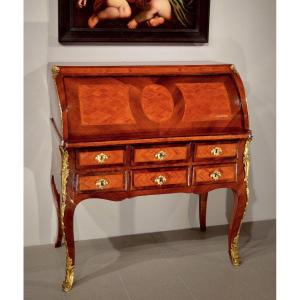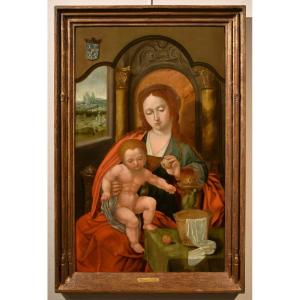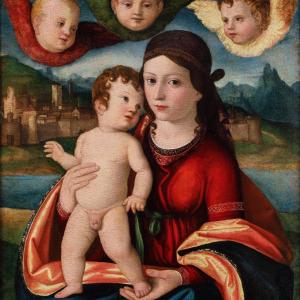Bolognese school of the seventeenth century
Circle Giovanni Battista Ramenghi, known as Bagnacavallo (Bologna, 1521 - 1601)
Oil painting on canvas (86 x 72 cm. - With antique frame 107 x 93 cm.)
All the details relating to this painting can be viewed at the following - LINK -
This interesting painting depicts one of the most widespread iconographic subjects in the Christian tradition, presented here according to an ancient and tested scheme that wants the Virgin in prayer and the Sleeping Child in the center of a tender devotional representation, completed by the presence of Saint Joseph, on the right, placidly leaning on his cane.
To enrich this canonical Holy Family appears on the right the little Saint John the Baptist who, as if wanting to address the viewer directly, makes a sign of silence with his hands so as not to disturb the little sleeper and to invite him to contemplate the scene with devotion.
Regarding the stylistic characteristics of our canvas, it is easy to grasp the preponderant influences of Bolognese painting, and in particular the relationship with the works of one of the greatest artists of the full sixteenth century, Giovan Battista Ramenghi.
The solid and clear volumes, the physiognomic features, the geometrically detected drapery and the gestural eloquence of the characters, as well as the clear layout in space, certainly allow to bring the execution closer to his pictorial way, although the solutions are taken from an analytical glance. more synthetic in the rendering of the figures, they lead more prudently to consider the canvas as a valid work of an author of his circle, to be placed in the early seventeenth century.
The painting presents us with one of the favorite themes of the Bolognese painter, or more likely by his clients, and frequently re-proposed by his workshop, albeit with always different compositional inventions. In our version we can detect all the elements that contributed to define its formal culture: from the classicism underlying the monumental balance of the group, of Bolognese heritage, to the clear mention of Raphael in the figure of Saint Joseph, up to the refinement of the Tuscan-Roman manner. inspirational of colors.
The excellent conservation conditions allow the vision of the splendid scene, capturing all the pictorial and chromatic peculiarities, with the pleasant and uniform crackle that characterizes the entire surface.
Giovanni Battista Ramenghi (Bologna, 1521 - 1601)
Son of Bartolomeo Ramenghi, known as Bagnacavallo, Giovanni Battista Ramenghi trained in his father's workshop. In 1535 he was already enrolled among the freshmen of Bolognese artists, but soon, at the request of Francesco Primaticcio, he moved to Fontainebleau, where he worked between 1537 and 1545 approximately. In 1546 he is in Rome, where he collaborates with Giorgio Vasari. Giovanni Battista refines his production with elegant inflections assumed by Pierino del Vaga, being first linked to Raphael's lesson deduced through his father. From 1555 we find it in Bologna, where it assumes a central role in painting linked to the Catholic Counter-Reformation, implementing skilfully balanced compositions between the sinuosity of the figures and their rigorous symmetrical arrangement, elaborating the themes with a clear and immediate religious message.
ADDITIONAL INFORMATION:
The work is sold complete with a pleasant frame and accompanied by a certificate of authenticity and a descriptive iconographic card.
We take care and organize the transport of the purchased works, both for Italy and abroad, through professional and insured carriers.
It is also possible to see the painting in the Riva del Garda gallery, we will be happy to welcome you to show you our collection of works.
Contact us, without obligation, for any additional information.
Follow us also on:
https://www.instagram.com/galleriacastelbarco/?hl=it
https://www.facebook.com/galleriacastelbarco/

















































 Le Magazine de PROANTIC
Le Magazine de PROANTIC TRÉSORS Magazine
TRÉSORS Magazine Rivista Artiquariato
Rivista Artiquariato